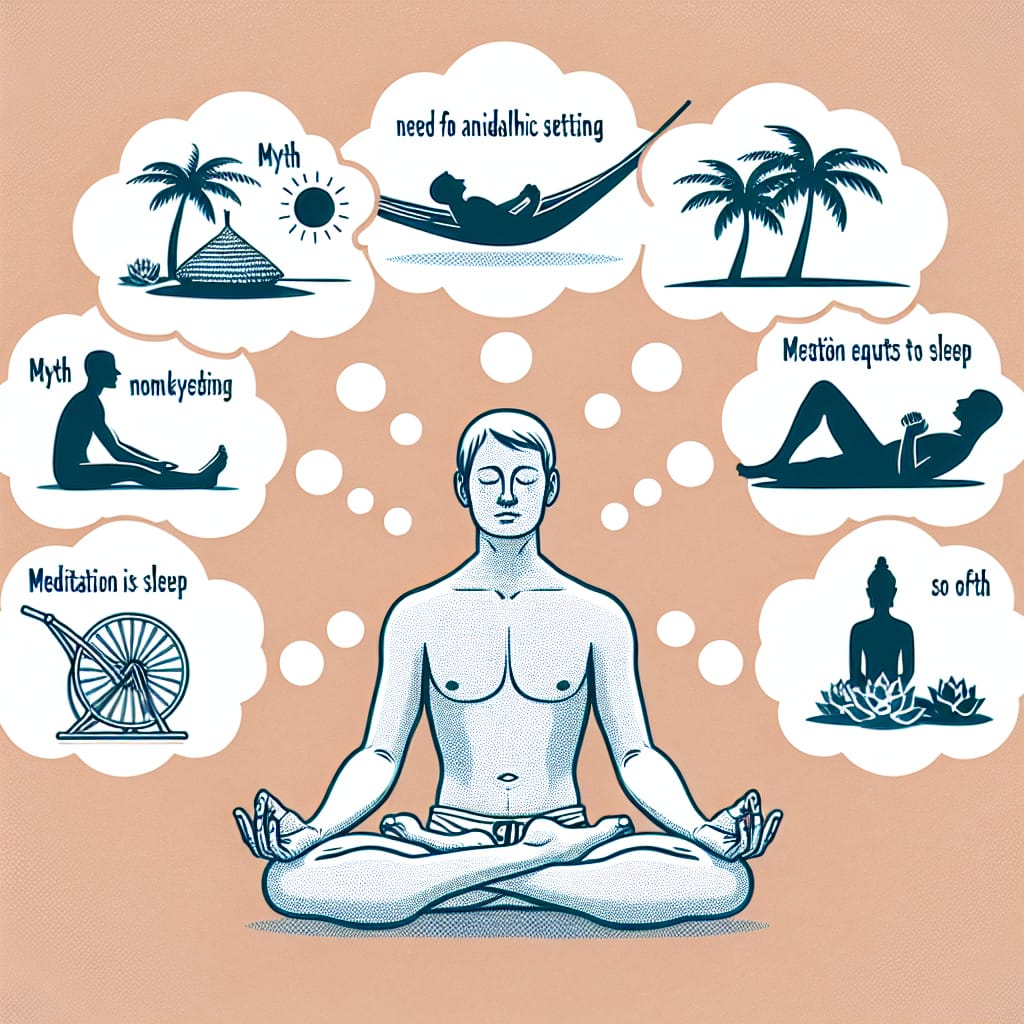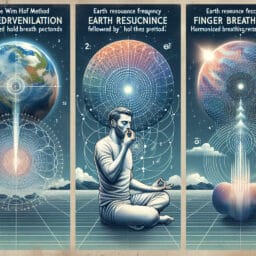
Understanding the Definition of Relaxation in Meditation
Table of Contents
- Understanding the Definition of Relaxation in Meditation
- The Importance of Relaxation in Meditation
- Techniques for Achieving Relaxation in Meditation
- The Role of Breathing in Relaxation and Meditation
- The Benefits of Relaxation in Meditation
- Common Misconceptions about Relaxation in Meditation
- Conclusion: Embracing Relaxation in Your Meditation Practice
Understanding the Definition of Relaxation in Meditation
Resting at the core of effective meditation, relaxation is more than just a state of calm; it’s an essential conduit that connects body and mind, laying a solid foundation for mindfulness practices. Practitioners often see relaxation as the first stepping stone on their journey to inner peace and wellness. It is not just about silencing the noise outside but also quelling the inner tumult, thus setting the stage for deeper introspection.
Different techniques can aid in acclimating to this tranquil state, each one designed to ease stress and facilitate a more profound connection with oneself. Among these are progressive muscle relaxation and autogenic training, which harness the power of visualization to relax each muscle group sequentially or invoke feelings of warmth and heaviness respectively – both leading towards an overall sense of relaxation.
Another effective tool in meditation practice is guided imagery—wherein you mentally visit calming environments like lush forests or serene beaches —that helps stimulate specific sensory experiences promoting tranquility. This technique taps into your imagination’s potential to elicit relaxation responses from your autonomic nervous system, resulting in reduced heart rate and eased tension.
Breathing exercises play a pivotal role in achieving this desired state as well. The deliberate slowing down of breath serves as an anchor that pulls you back when distracting thoughts try to steer your attention away from the present moment. As such, focusing on physical sensations during breathing becomes an exercise in grounding oneself amidst life’s constant ebb and flow.
The ultimate goal behind these varied techniques is not only stress relief but also fostering mindfulness—a practice rooted firmly in living fully aware within every passing moment rather than being lost amidst past regrets or future anxieties. Techniques like mindfulness-based stress reduction (MBSR) take this idea further by incorporating elements like body scan meditations along with yoga practices designed explicitly for cultivating awareness.
Such relaxation interventions have been shown scientifically as potent psychological interventions capable of reducing stress significantly over regular practice periods while improving physical health markers like high blood pressure. Moreover, emerging technologies such as heart rate variability biofeedback are shining a new light on the interplay of relaxation and meditation, underscoring how mastering one’s physiological responses can pave the way to attaining true mindfulness.
Indeed, whether you practice meditation in silence or prefer guided meditations, incorporating relaxation techniques is key. Not only do they help reduce stress but also serve as an excellent foundation for more advanced mindfulness training practices. So next time you sit down to meditate, remember to ease into that state of deep tranquility first—because when it comes to effective meditation, relaxation isn’t just a part—it’s pivotal.
The Importance of Relaxation in Meditation
In the realm of meditation, relaxation serves as a pivotal cornerstone. It is a state where the body and mind align in tranquility, setting the stage for more profound introspection in your meditation practice. The cultivation of this serene foundation is supported by an array of relaxation techniques that aim to not only reduce stress but also enhance overall physical health. Among these are progressive muscle relaxation and autogenic training – techniques that harness visualization to sequentially relax each muscle group or invoke feelings of warmth and heaviness respectively.
Guided imagery bolsters this process further by mentally transporting you to calming environments like lush forests or serene beaches, stimulating specific sensory experiences that promote tranquility. This effective tool taps into your imagination’s potential to elicit a relaxation response from your autonomic nervous system, resulting in reduced heart rate and eased tension. As such, guided imagery becomes a form of relaxation therapy designed to counteract life’s constant ebb and flow.
The deliberate slowing down of breath through breathing exercises also plays an integral role in achieving this desired state of calmness during meditation practice. Focusing on physical sensations during breathing provides an anchor pulling your attention back when distracting thoughts might veer it off course—an exercise essential in grounding oneself amidst life’s relentless waves.
Mindfulness practices lend themselves well to this process too; from mindfulness-based stress reduction (MBSR) which incorporates body scan meditations alongside yoga practices geared towards cultivating awareness—all aimed at relieving stress while fostering mindfulness—a practice deeply rooted in living fully aware within every passing moment rather than being lost amidst past regrets or future anxieties.
Scientific studies have underscored the value behind these varied techniques; showcasing how consistent application can significantly reduce stress over time while improving physical health markers such as high blood pressure—thus illustrating the health benefits derived from regular relaxation interventions.
Emerging technologies such as heart rate variability biofeedback are casting new light on the interplay between relaxation and effective meditation too—highlighting how mastering one’s physiological stress responses can pave the way to attaining true mindfulness. Whether you prefer practicing meditation in silence or using guided meditations, incorporating relaxation techniques and practices is key. They not only offer stress relief but also serve as a sturdy foundation for more advanced mindfulness training practices—an essential aspect of achieving effective meditation. Therefore, embracing relaxation techniques is more than just a vital part of your meditation practice—it’s an integral element in the journey towards self-discovery and inner peace.
| Relaxation Techniques | Description | Benefits |
|---|---|---|
| Progressive muscle relaxation and autogenic training | Techniques that harness visualization to sequentially relax each muscle group or invoke feelings of warmth and heaviness. | Reduces stress, enhances overall physical health. |
| Guided imagery | Mentally transports you to calming environments, stimulating specific sensory experiences that promote tranquility. | Reduces heart rate, eases tension, acts as a form of relaxation therapy to counteract life’s stress. |
| Breathing exercises | The deliberate slowing down of breath, focusing on physical sensations during breathing. | Helps achieve a state of calmness during meditation, provides an anchor to attention, essential in grounding oneself. |
| Mindfulness-based stress reduction (MBSR) | Incorporates body scan meditations alongside yoga practices aimed at cultivating awareness. | Helps relieve stress while fostering mindfulness—a practice of living fully aware in the present moment. |
| Heart rate variability biofeedback | An emerging technology that helps understand the interplay between relaxation and effective meditation. | Helps master physiological stress responses, paving the way to attaining true mindfulness. |
Techniques for Achieving Relaxation in Meditation
Delving into the realm of relaxation in meditation unveils a labyrinth of techniques, each designed to cultivate tranquility and grounding – a vital cornerstone for mindfulness practices. Among these methods, progressive muscle relaxation has gained recognition as an effective tool to reduce stress. This technique harnesses the power of visualization, sequentially relaxing each muscle group in your body and fostering a deep sense of physical ease. Coupled with autogenic training—another potent relaxation technique invoking feelings of warmth and heaviness—it becomes possible to transform your stress response entirely.
But how exactly do you practice these relaxation techniques effectively? It starts by setting aside dedicated time daily for your meditation practice. Position yourself comfortably, close your eyes, and focus on one specific object or sensation—be it the rhythm of your breath or the sensation under your fingertips during massage therapy—to anchor attention back into the present moment.
Breathing exercises also play a pivotal role in achieving this desired state during meditation practice; their emphasis on deliberate slowing down serves as an essential conduit connecting body and mind—a testament to their efficacy as psychological interventions against stress. The trick is maintaining awareness of physical sensations throughout—like feeling your chest rise with each inhale or acknowledging how air escapes smoother with every exhale—all while redirecting any straying thoughts back solely onto breathing patterns.
Guided imagery bolsters this process further by transporting you mentally to calming environments like lush forests or serene beaches—the perfect antidote for life’s relentless ebb and flow. This powerful method taps into imagination’s potential to elicit a relaxation response from our autonomic nervous system—a natural mechanism for reducing stress that leads not only towards lower heart rate but also improved high blood pressure indicators over time.
However, it is worth noting that not all paths towards relaxation are without challenges—even when backed by science like mindfulness-based stress reduction programs which incorporate elements like yoga practices alongside body scan meditations designed explicitly for cultivating increased awareness.
Some may struggle initially with maintaining focus or find it challenging to visualize during guided imagery exercises. This is where relaxation training comes in handy, offering step-by-step guidance that helps acclimate practitioners to harnessing their mind for inner tranquility effectively.
In the grand scheme of things, embracing these relaxation practices isn’t just about stress relief—it’s an integral part of your journey towards self-discovery and inner peace. And while the path may seem daunting at times, regular practice remains key; after all, as with any skill—meditation and relaxation techniques get easier over time.
Remember: The benefits reaped extend beyond mere stress reduction; they can significantly improve overall physical health markers too—from high blood pressure to heart rate variability—and provide a sturdy foundation for more advanced mindfulness training practices. Therefore, understanding and incorporating these techniques in your meditation practice are essential steps towards effective meditation—a journey well worth embarking on.
| Technique | Description | Benefits |
|---|---|---|
| Progressive Muscle Relaxation | Sequentially relaxes each muscle group in the body through visualization. | Reduces stress, promotes physical ease. |
| Autogenic Training | Invokes feelings of warmth and heaviness, transforming the stress response. | Alters stress response, provides deep relaxation. |
| Breathing Exercises | Focus on deliberate slowing down to connect body and mind. | Reduces stress, connects body and mind, promotes awareness of physical sensations. |
| Guided Imagery | Uses imagination to mentally transport to calming environments. | Reduces stress, lowers heart rate, improves high blood pressure. |
| Relaxation Training | Provides step-by-step guidance to acclimate practitioners to relaxation techniques. | Helps maintain focus, enhances ability to visualize, promotes inner tranquility. |
The Role of Breathing in Relaxation and Meditation
Controlled breathing is not just an integral part of relaxation practices, but it also serves as a dynamic bridge connecting body and mind during meditation practice. Deliberately slowing down your breath can induce a state of tranquility that’s pivotal for achieving effective mindfulness meditation. Specific breathing exercises like diaphragmatic breathing or box breathing are designed to ease stress and elicit the relaxation response—a natural mechanism within our autonomic nervous system that helps counterbalance the stress response. As you inhale deeply, filling up your diaphragm, and then exhale slowly, you’re guiding your body towards a calmer state. This process kindles the relaxation response in your body—reducing heart rate, lowering high blood pressure, and promoting physical health.
Moreover, these exercises serve as psychological interventions against life’s relentless ebb and flow by anchoring attention back to the present moment—an essential aspect of mindfulness training. But how does this work? Imagine sitting quietly in your favorite nook at home; close your eyes and focus on feeling each breath as it enters and leaves your body—this simple act turns into an effective tool for grounding oneself amidst daily chaos.
The physiological effects of controlled breathing go beyond just reducing stress; they extend to modulating one’s heart rate variability—a key health marker as per recent studies involving heart rate variability biofeedback techniques. This intricate interplay between controlled breathing and our physiological responses underscores how vital relaxation techniques are within our meditation practice.
Embracing these practices goes hand-in-hand with other equally beneficial methods such as progressive muscle relaxation, guided imagery or autogenic training—all tools designed to invoke deeper states of calm through visualization. Whether used standalone or coupled with other methods like massage therapy or mindfulness-based stress reduction programs—breathing exercises remain central to fostering deep relaxation in any form of meditation guided meditation included.
In essence, cultivating such mindful awareness via controlled breathing forms the crux of effective meditation—not only does it offer stress relief, but it also sets the stage for more profound introspection and self-discovery—a testament to the power of relaxation meditation.
The Benefits of Relaxation in Meditation
The role of relaxation in meditation is a key factor not only in achieving mental tranquility but also in promoting physical health. The deliberate practice of relaxation techniques such as progressive muscle relaxation and autogenic training evoke a natural mechanism known as the relaxation response, which is linked to the reduction of stress and improved health markers like heart rate and high blood pressure. This response, initiated by our autonomic nervous system, counteracts the harmful effects of prolonged stress exposure commonly experienced in today’s fast-paced life. Moreover, these practices can be an effective tool for grounding oneself amidst life’s chaos by anchoring attention back to the present moment — an essential aspect of mindfulness practices.
Relaxation training often incorporates breathing exercises and guided imagery as potent psychological interventions that provide not only immediate stress relief but also long-term benefits through consistent practice meditation. Focusing on physical sensations during deep diaphragmatic breathing or visualizing calming environments serve to enhance one’s ability to manage their own stress response effectively.
On another note, scientific studies have recently shed light on the intricate interplay between controlled breathing and heart rate variability biofeedback—highlighting how mastering one’s physiological responses could significantly improve overall well-being. Additionally, programs such as mindfulness-based stress reduction have been proven effective at easing stress while fostering mindfulness—a state of being fully immersed in the present moment.
Embracing these relaxation practices indeed has far-reaching implications beyond just improving one’s meditation practice—it enhances quality of life too. They equip individuals with tools to navigate life’s ups and downs more resiliently while offering invaluable insights into self-discovery during their journey through mindfulness meditation. Thus, whether you’re considering taking up meditation or are already practicing it regularly—prioritizing relaxation techniques in your routine remains crucial for reaping its full spectrum of benefits.
Common Misconceptions about Relaxation in Meditation
Delving deeper into the realm of relaxation in meditation, it’s essential to debunk some common myths that can potentially hinder your progress. One prevalent misconception is equating relaxation with lethargy or inactivity; however, the essence of relaxation practices lies not in inertia but dynamic engagement with one’s internal state. These practices are a powerful psychological intervention that foster mindfulness and manage stress response effectively, contrary to passive idleness. Moreover, relaxation techniques such as progressive muscle relaxation and autogenic training are not quick fixes for stress relief but require consistent practice meditation for substantial improvements. Misunderstanding these principles may lead to unrealistic expectations and frustration, undermining the profound health benefits they offer – from reducing stress to improving high blood pressure. Hence, understanding and incorporating authentic knowledge about these techniques is pivotal for a successful journey towards mindfulness meditation.

Conclusion: Embracing Relaxation in Your Meditation Practice
In the realm of mindfulness meditation, relaxation techniques such as progressive muscle relaxation and autogenic training serve as a crucial foundation. These practices, intended to elicit the body’s natural relaxation response, are not only an effective tool for reducing stress but also have profound implications on physical health markers like heart rate and high blood pressure. By incorporating breathing exercises and guided imagery into their routine, individuals can achieve a deeper state of tranquility—an essential aspect of mindfulness-based stress reduction. This dynamic engagement with one’s internal state through relaxation therapy redirects attention back to the present moment—an integral part of effective meditation practice. Therefore, embracing these scientifically-backed psychological interventions propels individuals towards better stress management while fostering self-discovery during their journey through mindfulness training.
Q: What is the definition of relaxation in meditation?
A: Relaxation in meditation refers to the process of releasing tension and achieving a state of calm. It’s an integral part of meditation that involves calming the mind and relaxing the body to achieve a deep state of peace.
Q: Why is relaxation important in meditation?
A: Relaxation is crucial in meditation as it enhances its benefits. A relaxed mind and body can more effectively achieve the desired state of clarity, inner peace, and wisdom that meditation provides. Scientific studies also support the importance of relaxation in meditation, citing it as key factor in the effectiveness of the practice.
Q: What are some techniques for achieving relaxation in meditation?
A: Various techniques for achieving relaxation during meditation include controlled breathing exercises, focusing the mind on a particular object or mantra, progressive muscle relaxation, and visualization techniques. Each has its own benefits and challenges but can contribute significantly to a deeper and more effective meditation.
Q: How does breathing play a role in relaxation and meditation?
A: Controlled breathing can significantly induce relaxation. It helps decrease the heart rate and blood pressure, relaxing the body, and focusing the mind. Specific breathing exercises, such as deep breathing and diaphragmatic breathing, are often used to enhance relaxation during meditation.
Q: What are the benefits of relaxation in meditation?
A: Relaxation in meditation offers numerous physical and mental health benefits. It can help reduce stress, anxiety, and depression, improve concentration and attention, and enhance overall wellbeing and quality of life. Some scientific studies also provide evidence of these benefits.
Q: Are there common misconceptions about relaxation in meditation?
A: Yes, there are common myths about relaxation in meditation. Some people mistakenly believe that relaxation means being completely free of thoughts or that it’s the same as sleep. These misconceptions can hinder the effectiveness of one’s meditation practice and lead to misunderstanding the true purpose and benefits of meditation.
Q: How can I incorporate relaxation techniques into my own meditation practice?
A: You can incorporate relaxation techniques into your meditation practice by learning and practicing specific techniques such as controlled breathing, progressive muscle relaxation, or visualization. It may also be beneficial to use resources for further learning and practice including books, online sources, or guided meditation sessions led by experienced practitioners.



